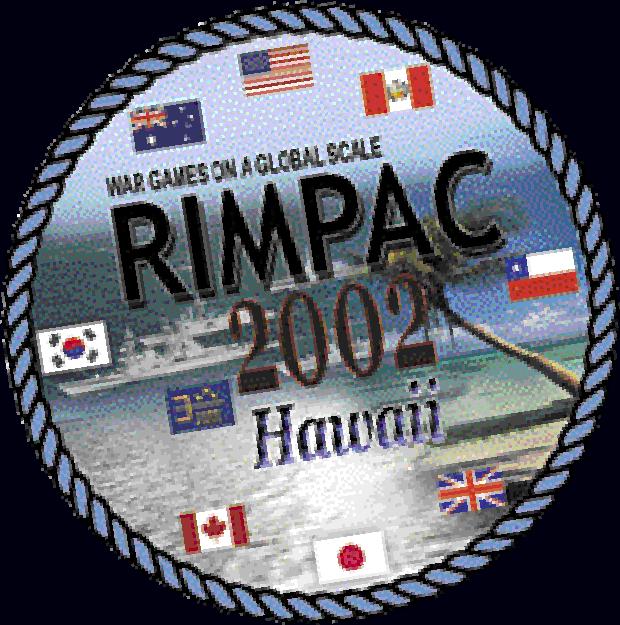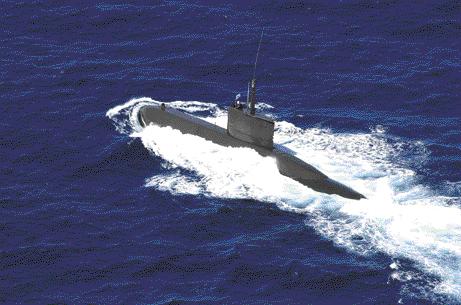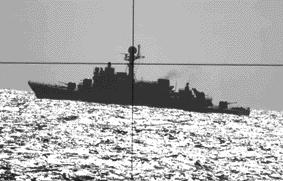
11 minute read
Focusing on ASW in RIMPAC 2002
LCDR Scott Harrington sat in the wardroom of USS Chicago (SSN-721) with a big smile on his face, a look of re l i e f perhaps. And why not? As Executive Officer, he and his crew had had their hands full this summer preparing for a change of command in addition to supporting Rim of the Pacific (RIMPAC) 2002, a major maritime exercise conducted in the waters off Hawaii, with maritime forces from Australia, Canada, Chile, Peru, Japan, the Republic of Korea, the United Kingdom, and the United States.
RIMPAC 2002 did not focus on the traditional carrier battle group scenario, but rather emphasized a heavy anti-submarine warfare (ASW) theme, while honing the tactical proficiency of participating units –surface combatants, submarines, tactical aircraft, and amphibious forces – in a wide variety of combined operations at sea.
Advertisement
C h i c a g o s u p p o rted the Mu l t i n a t i o n a l Fo rce (MNF) during the work-up or familiarization stage – 1 to 10 July – and

The Collins-class Australian Submarine HMAS Sheean (SSG-77) joins a flotilla off the coast of Kauai, Hawaii, with numerous other international naval vessels.
in the tactical phase – 12 to 15 July. On the last two days of the tactical phase, C h i c a g o switched roles to support the Opposing Force (OPFOR) for the simulated war on 16/17 July. In addition to C h i c a g o, USS Key We s t (SSN-722) supported the Bilateral Force (BIF) during
FOCUSING ON ASW the work-up and tactical phases. Foreign navy submarine assets from Au s t r a l i a , Ko rea, and Japan also part i c i p a t e d . Harrington noted that the goal of this RIMPAC was to exercise ASW tactics IN RIMPAC 2002 with the participating nations in both familiarization exercises and set scenarios. by JOCS(SW) Phil Eggman, USN “This is where we went out and tried to be stealthy; doing approaches on other ships and allowing them to get a good look at us,” he said.
A typical familiarization day would have a submarine-on-submarine focus. For example, Chicago would move out and work with a South Korean boat, each submarine taking turns tracking the other while generating different kinds of radiated noise and trying a variety of evolutions, so each could get familiar with the other’s operating modes.
Next Chicagowould work with the surface ships and patrol aircraft. “For some units who had never exercised with a submarine before, this allowed them to learn what a real submarine looks like and sounds like,” Harrington said. “On the surface we are very difficult to see, and when we’re submerged? Well, hopefully we’re very stealthy.”
In the tactical phase, the scenarios were not quite so canned. “We had a beginning point, and an ending point,” Harrington explained. “How the opposing force was going to get from one to the other was up to them. Our job during this phase was to go to periscope depth and perform an all-sensor s e a rch and try to figure out what the opposing force was doing. “We found the fleet’s aerial screen of P-3 and helicopter anti-submarine aircraft was really quite effective,” he continued. “We would try to get in front of the battle group, even if we didn’t think they had us. We went deep and tried to get in front of them, but by the time we got back up, the fleet had reversed course and gone the other way.”
According to LT Brian Guise, Chicago’s Communications Officer, the boat had some real challenges in the beginning of the exercise. “Our communications were not well aligned with what the battle group had, so we had to make some work-arounds getting our communications set up,” he said. But his crew was able to come up with an alternate network using logistics links and satellite and UHF radio to communicate with the battle group commander in real time. Chicago’s Commanding Officer, CDR Daniel Prince, wanted to send immediate feedback on each evolution, which Harrington said enhanced RIMPAC ’s success after each engagement. The battle group commander knew immediately what worked and what didn’t in trying to screen his surface action group. “Never underestimate the value of a good, one-page concise message,” said Harrington, noting that Prince was probably the best writer he had ever worked for. “He could say more in one page than what a lot of guys would take five pages to say. He would write, ‘this is what we saw, this is what we did, this is what
worked, and this is what didn’t. Why don’t you guys try this?’”
“I believe by the end of RIMPAC everyone was more prepared to go to war against a submarine,” Harrington added, noting that at least at the beginning of the exercise, conditions were poor for active sonar, and it offered no real performance advantage for the surface fleet. “All it really did was let us know who they were and where they were,” he said, while admitting that they were not really after the warships anyway. The targets they especially wanted were the replenishment oilers USNS Yukon (T-AO-202) and USNS Tippecanoe (T-AO199). “We were going to shoot out the oil cans and when the rest of the fleet ran out of gas, we would pick them off one by one.”
During the exercise, participating ships would know the assignment of an adversary’s water space – large blocks of water, 50 to 70 miles square. Chicago would get an intelligence spot telling them that the opposing forces were – perhaps – to the northeast t rying to go to the s o u t h west. The boat would have a rough start time, and from there, it was up to them to decide on the best s e a rch tactic. “If they were going active, then we we re going deep, ” Harrington said. “We could hear their active sonar pounding away from the northeast, and we could watch them from deeper water.
“ Un f o rtunately for the MNF, the ship that we wanted to shoot most, the oiler, was always the loudest ship and the one we could pick up the easiest,” he continued. “We would listen specifically for the auxiliary, and after we had worked with them a couple of times, we had some knowledge on how fast their shaft was normally turning, listening for a four blade screw, doing about a 78 shaft rpm, and we knew that was our prize.”
What is the benefit of exercising with foreign navies?
“Well, it makes us think – provides us with new ideas on how ASW can work,” said Harrington. “Sometimes having a really awesome platform like Chicago can exaggerate your sense of invincibility, and a nuclear submariner is tempted to think he has this advantage over any diesel submarine. But we saw these guys use the environment around them and do some pretty incredible things,” he continued. “Diesels are very stealthy, and a diesel submarine operating quietly on its battery in the environments we work in can be pretty scary because you just don’t know how close you can get to one and not even know it’s there.”
The crew aboard Chicago could not say enough about how impressed they were by their Australian counterparts. “I learned a ton from the Australians,” said LT Mike Lowry, Chicago’s Combat Systems Officer. “Some of the tactics that they used were incredible,” he continued. “We are used to just charging right in and punching the enemy in the eye, but they knew exactly

RADM John R. Hines, Jr., Deputy Commander, U.S. 3rd Fleet, addresses media and RIMPAC 2002 participants with opening remarks at Sharkey Theater, Naval Station, Pearl Harbor, Hawaii.
what they could get away with, and they did it every time. They did all the right things. Knowing that there are submariners out there who are that good makes you very glad those guys are on our side.”
But LCDR Harrington observed that the submarines Chicago went up against were not their primary threat. Moreover, they were not even worried about surface ships, because the latter’s excessive use of active sonar tended to mask the boat’s movements.

(above) The Republic of Korea submarine Nadaeyung (SS-069) surfaces while con ducting training exercises during RIMPAC 2002. This exercise was designed to improve tactical proficiency in a wi de array of combined operations at sea, while building cooperation and fostering mutual understanding a mo ng parti c i p a t i ng na t io ns.
(right) A Chilean ship is sighted through a U.S. submarine periscope.
Harrington felt that the real threat came from aircraft, because Chicagowas operating in shallow water with a high probability of being visually detected from the air. He recalled one scenario in which three P-3s and two helicopters were prosecuting the boat relentlessly. “That was a nightmare to try and get through,” he said. “We could never get a good solid look, 15 seconds maybe, because our periscope radar detector was just screeching, and all our early warning systems were going off. They got right around us. It is pretty intimidating

when you see all the radars directed at you from all around, and you can hear the buoys splashing in the water.
“But there were also many times when the fleet didn’t get by us,” he added. “I think we had some pretty good hunting out there.” For example, Harrington described the last approach of the tactical phase of the exercise when Chicago decided to penetrate the screen instead of just sitting on the fence and shooting from a distance. “We got inside, and sitting there were five ships,” he said, clearly showing his satisfaction about getting inside the screen. “The mayhem factor is on your side when you are right in the middle of them, which is probably where they least expect to look for you. We would go up and take a look around and the skipper would say, ‘Ahhh, this guy dies next.’”
“We felt like a shark in the middle of a school of fish,” said Lowry. “ We had them totally surrounded and there was nothing they could do about it.”
“What do you do when the guy on your right blows up,” Harrington said. “What do you do next? Turn left? Turn right? We got underneath their aircraft, let the screen guy go over, and up we went, and there we were with all those big, fat, juicy oilers.”
During the war phase, Chicago operated the same as during the tactical phase, working in a small block of water, with forces at opposite ends. “We would try to go from here to there, and our job was to get in front of the ships and not let them get by us,” Harrington said.
During the war phase, C h i c a g o also penetrated the screen. “I remember the amphibious dock landing ship USS Duluth (LPD-6) was on one side, and the oiler was on the other with the screen all around, and we were smack dab in the middle,” LCDR Harrington said. “We shot the oiler and two e s c o rts and then we shot D u l u t h f ro m behind. With the gas can blown up, the rest of the fleet wasn’t going anywhere fast.”
“When we started out in this exercise, we knew that it was supposed to be a learning environment for everybody,” said LT Guise. “Everyone got much better as we went along, because we were sending messages to each adversary saying, ‘this is how we killed you this time,’ and ‘this is how we killed you that time,’ or ‘why we didn’t kill you.’ They were getting instantaneous feedback, and they kept getting better. It was good to see them get better, because we got better too.”
LT Lowry agreed, noting that the P-3 operators continued to improve their ability to prosecute submarines beginning to the end. “I can guarantee you, from my standpoint as an operator, that the P-3s tripled their efficiency at submarine prosecution, while the surface ships doubled their ability to avoid being destroyed by a submarine,” he said. “You could see it in the way they operated. Everyone got better at ASW –everyone.”
JOCS(SW) Eggman is the Leading Petty Officer at COMSUBPAC Public Affairs.






